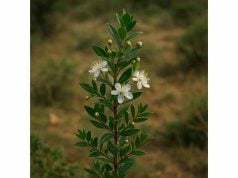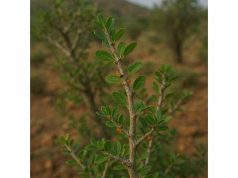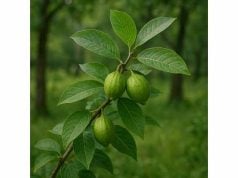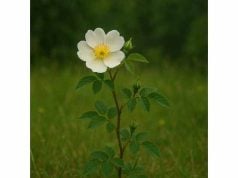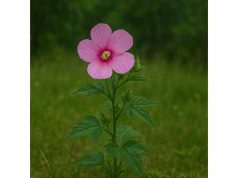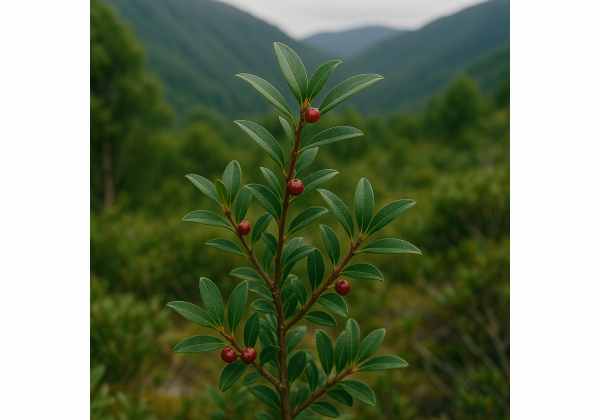
Mountain Pepper is an aromatic herb prized for its robust, peppery flavor and versatile therapeutic applications. Rich in essential oils, bioactive alkaloids, flavonoids, and other phytochemicals, this herb offers notable antioxidant, anti-inflammatory, and antimicrobial benefits. Traditionally used to enhance culinary dishes, support digestive health, and alleviate respiratory discomfort, Mountain Pepper has also attracted attention in modern natural health research. Its unique chemical profile supports immune function and metabolic balance, while its distinctive taste adds a gourmet edge to recipes. This comprehensive guide delves into its botanical characteristics, chemical composition, health benefits, practical uses, and scientific research to illuminate Mountain Pepper’s full potential.
Table of Contents
- Floral Profile and Morphological Identification
- Chemical Composition and Key Bioactives
- Therapeutic Advantages and Core Attributes
- Practical Applications and Safety Guidelines
- Research Discoveries and Pivotal Studies
- Frequently Asked Questions
Floral Profile and Morphological Identification
Mountain Pepper is a distinctive herb that thrives in rugged, elevated terrains and exhibits a striking visual appeal along with its characteristic pungent aroma. Botanically, it is believed to belong to a unique branch of the Piperaceae family, sharing certain attributes with both traditional pepper species and other aromatic herbs. The plant displays an upright growth habit with woody stems and a bushy appearance. Its leaves are typically dark green, ovate to lanceolate in shape, and possess a slightly glossy texture with subtle serrations along the margins. When gently crushed, the leaves emit an intense, peppery aroma that is both refreshing and invigorating.
The flowering phase of Mountain Pepper occurs during the warmer months. Small, inconspicuous flowers—often pale or greenish in hue—cluster densely at the tips of branches. These flowers, though modest in appearance, are essential for the plant’s reproductive cycle, attracting a variety of pollinators such as native bees and butterflies. The subsequent formation of tiny, capsule-like fruits adds to the plant’s distinctive botanical profile. These fruits, which encase the seeds, contribute to the dispersal mechanism by which Mountain Pepper propagates in its natural habitat.
Found predominantly in mountainous regions, Mountain Pepper thrives in well-drained, rocky soils with moderate to high levels of organic matter. Its natural habitat is characterized by cool temperatures, high altitude, and exposure to intense sunlight and wind, conditions that have led to several adaptive traits. For instance, the plant has evolved a robust root system capable of anchoring it firmly in shallow, nutrient-poor soils while efficiently absorbing water during brief periods of rainfall. The waxy surface of its leaves also minimizes water loss, an adaptation that is crucial in its often harsh, elevated environment.
Moreover, the morphology of Mountain Pepper reflects an evolutionary finesse that balances both survival and utility. Detailed microscopic studies have revealed that the leaf surfaces are covered with glandular trichomes—small hair-like structures—that are responsible for the synthesis and storage of essential oils. These oils not only impart the herb’s potent flavor and aroma but also serve as a natural defense mechanism against herbivores and pathogenic microbes. The arrangement of the leaves in an alternate pattern along the stems maximizes sunlight exposure, enhancing the plant’s photosynthetic efficiency and contributing to its vigorous growth even under less-than-ideal conditions.
Historically, indigenous communities and early settlers in mountainous regions have revered Mountain Pepper not just for its culinary applications but also for its medicinal properties. Ethnobotanical records suggest that traditional healers used infusions made from its leaves to treat digestive disturbances and respiratory ailments, leveraging both its aromatic and therapeutic qualities. Today, its unique combination of visual appeal, robust growth characteristics, and bioactive potential continues to inspire both herbalists and gourmet chefs alike.
In summary, the botanical and morphological features of Mountain Pepper underscore its adaptability and multifunctionality. From its resilient woody stems and glossy, aromatic leaves to its subtle yet efficient flowering and fruiting mechanisms, every aspect of its anatomy plays a role in its survival and utility. This detailed identification not only aids in the proper recognition and cultivation of Mountain Pepper but also sets the stage for understanding the complex interplay between its physical form and its potent medicinal properties.
Chemical Composition and Key Bioactives
The therapeutic prowess of Mountain Pepper is deeply rooted in its rich and diverse chemical composition. Modern analytical techniques have unveiled a complex matrix of bioactive compounds that work synergistically to deliver a range of health benefits. These compounds not only contribute to its distinctive flavor and aroma but also play critical roles in its medicinal actions. Here, we explore the primary active ingredients that define the unique profile of Mountain Pepper.
- Piperine-like Alkaloids
One of the hallmark features of Mountain Pepper is its content of alkaloid compounds similar to piperine, which is famously present in black pepper. These alkaloids are known for their bio-enhancing properties, facilitating better absorption of nutrients and other phytochemicals in the body. They contribute to the herb’s pungent flavor and are implicated in a variety of pharmacological activities, including anti-inflammatory and antioxidant actions. - Essential Oils
The volatile fraction of Mountain Pepper is composed of a diverse array of essential oils. These oils, which include monoterpenes and sesquiterpenes, are largely responsible for the herb’s robust aroma and peppery taste. Among these, compounds such as limonene and cineole have been identified, offering notable antimicrobial, anti-inflammatory, and decongestant properties. The essential oils also contribute to the herb’s use in aromatherapy, where their invigorating scents stimulate mental clarity and emotional well-being. - Flavonoids
Mountain Pepper is rich in flavonoids—naturally occurring polyphenolic compounds that exhibit potent antioxidant activities. Flavonoids such as quercetin, kaempferol, and rutin are known to scavenge free radicals, thereby protecting cells from oxidative damage. Their anti-inflammatory properties further enhance the herb’s ability to modulate immune responses and reduce chronic inflammation, which is a contributing factor to many degenerative diseases. - Tannins
Tannins are another important group of compounds present in Mountain Pepper. These polyphenols possess astringent properties that help in tightening tissues and reducing inflammation. They also contribute to the herb’s antimicrobial activity by precipitating proteins and inhibiting the growth of certain pathogens. Tannins play a significant role in traditional remedies aimed at treating gastrointestinal disturbances and skin infections. - Phenolic Acids
Phenolic acids such as caffeic acid and ferulic acid are present in appreciable amounts. These compounds further enhance the antioxidant capacity of Mountain Pepper, working in tandem with flavonoids to neutralize free radicals. Their presence supports cellular health and may contribute to protective effects against conditions associated with oxidative stress, including cardiovascular diseases and certain cancers. - Terpenoids
In addition to essential oils, Mountain Pepper contains non-volatile terpenoids that have been shown to exhibit anti-inflammatory and anticancer activities. These compounds, while present in lower concentrations, add another layer to the herb’s complex bioactivity. They are involved in modulating various biochemical pathways and can influence the body’s immune response. - Other Minor Constituents
A range of minor bioactive components, including saponins and glycosides, have also been detected in Mountain Pepper. Although they occur in smaller amounts, these compounds may contribute to the overall therapeutic effect by supporting metabolic processes, enhancing the bioavailability of other compounds, and providing additional antimicrobial and anti-inflammatory benefits.
The synergy among these diverse compounds is what sets Mountain Pepper apart as a powerhouse herb in traditional and modern herbal medicine. While each individual component offers its own set of benefits, their collective action amplifies the overall efficacy of the herb. Advanced research continues to elucidate the precise mechanisms by which these compounds interact within the body, paving the way for new applications and formulation strategies.
Innovative extraction techniques and sophisticated chromatographic analyses have allowed scientists to isolate and study these compounds in detail. This ongoing research not only validates traditional uses but also opens up promising avenues for the development of novel therapeutic agents derived from Mountain Pepper. The delicate balance between its beneficial bioactives and the need for precise dosage underscores the importance of continued research and standardization in herbal medicine.
In conclusion, the intricate chemical composition of Mountain Pepper underpins its robust medicinal properties. From piperine-like alkaloids and essential oils to flavonoids, tannins, and terpenoids, each component plays a vital role in its health-promoting effects. This multifaceted phytochemical profile not only explains the herb’s long-standing use in traditional medicine but also positions it as a subject of interest in contemporary scientific research.
Therapeutic Advantages and Core Attributes
Mountain Pepper offers a wide spectrum of health benefits, making it a valuable herb in both traditional remedies and modern wellness practices. Its multifaceted therapeutic properties stem from a rich blend of bioactive compounds that work synergistically to promote overall health. The herb is widely recognized for its antioxidant, anti-inflammatory, antimicrobial, and digestive support properties, which contribute to its broad range of applications.
One of the primary advantages of Mountain Pepper is its potent antioxidant capacity. The flavonoids and phenolic acids present in the herb help neutralize free radicals and reduce oxidative stress—a key factor in aging and chronic disease development. Regular consumption of Mountain Pepper, whether as an infusion or a culinary spice, may help protect cells from oxidative damage and support long-term health.
Mountain Pepper is also celebrated for its anti-inflammatory effects. The essential oils and terpenoids within the herb help mitigate inflammatory responses, making it beneficial for managing conditions such as arthritis, muscle soreness, and other inflammatory disorders. Its ability to reduce inflammation can provide relief from chronic pain and improve mobility and quality of life.
Digestive health is another area where Mountain Pepper excels. Traditionally, the herb has been used to stimulate the digestive system, enhancing enzyme production and promoting healthy gut motility. This can alleviate symptoms such as bloating, indigestion, and mild gastrointestinal discomfort. The antimicrobial properties of its essential oils also contribute to maintaining a balanced gut microbiota, further supporting digestive wellness.
Moreover, Mountain Pepper exhibits notable antimicrobial and antiviral activities. Its bioactive compounds help inhibit the growth of harmful bacteria and viruses, which can be particularly beneficial during seasonal illnesses. This protective effect extends to respiratory health, where inhaling diluted vapors or using the herb in steam therapies can help clear nasal congestion and ease symptoms of colds and sinusitis.
The herb’s therapeutic potential extends beyond physical health, as it also influences mental and emotional well-being. The invigorating aroma of Mountain Pepper has been associated with enhanced mental clarity and mood improvement. Aromatherapy practices utilizing its essential oil can help reduce stress and anxiety, promoting a sense of calm and balance in hectic environments.
Additionally, Mountain Pepper supports cardiovascular health. Its antioxidant and anti-inflammatory properties contribute to improved blood circulation and may help lower blood pressure. By reducing oxidative stress and inflammation within the vascular system, the herb supports overall heart health and may reduce the risk of developing cardiovascular diseases.
It is important to note, however, that while Mountain Pepper offers substantial health benefits, its potent bioactive profile necessitates careful usage. The same compounds that confer therapeutic benefits can be harmful if consumed in excessive quantities. Therefore, moderation and adherence to proper dosage guidelines are critical to ensuring safety and maximizing benefits.
In summary, the therapeutic advantages and core attributes of Mountain Pepper encompass a wide array of health-promoting effects. From bolstering antioxidant defenses and reducing inflammation to supporting digestive and cardiovascular health, this herb offers a holistic approach to wellness. Its dual role in promoting both physical and mental well-being makes it an indispensable component of natural health practices, provided it is used judiciously and in accordance with established guidelines.
Practical Applications and Safety Guidelines
Mountain Pepper is celebrated not only for its potent therapeutic properties but also for its versatile applications in culinary, medicinal, and cosmetic realms. However, given the strength of its bioactive compounds, proper usage, precise dosage, and safety measures are essential to harness its benefits while avoiding adverse effects.
Culinary Uses
In the kitchen, Mountain Pepper is utilized as a spice to add a distinctive, peppery zest to various dishes. Its robust flavor can enhance meat marinades, stews, sauces, and even salad dressings. A small pinch of dried Mountain Pepper, or a few drops of its essential oil, can elevate the flavor profile of a dish. Chefs value its ability to introduce a spicy kick without overpowering other ingredients. Additionally, the herb is sometimes incorporated into specialty teas and infusions, offering a warming, aromatic beverage that complements both sweet and savory recipes.
Medicinal Applications
Traditionally, Mountain Pepper has been employed as a natural remedy for a variety of ailments. Herbal infusions made from the leaves or fruits are used to stimulate digestion, alleviate respiratory congestion, and ease inflammatory conditions. In aromatherapy, diffused Mountain Pepper essential oil can help clear nasal passages and reduce stress. Topically, diluted extracts may be applied to sore muscles or joints to mitigate pain and inflammation. When used medicinally, it is crucial to adhere to precise dosage recommendations, as even small deviations can alter its efficacy or lead to unwanted side effects.
Cosmetic and Aromatherapy Uses
The essential oils extracted from Mountain Pepper are also valued in the cosmetic industry. They are incorporated into skin care formulations to help combat acne, reduce signs of aging, and improve overall skin tone through their antioxidant properties. In aromatherapy, the herb’s energizing scent is believed to uplift mood and sharpen mental focus, making it a popular choice for diffusers and personal inhalers.
Dosage Recommendations and Preparation
Given the potency of Mountain Pepper’s active compounds, particularly its alkaloids and essential oils, precise dosage is imperative. For culinary purposes, a light sprinkle or a few drops of oil is typically sufficient. For medicinal infusions, it is recommended to use no more than one-half teaspoon of dried herb per cup of hot water, steeped for 5–7 minutes. When using essential oil, dilute it with a carrier oil at a concentration of 1–2% for topical application. Always conduct a patch test before applying any new formulation to the skin.
Safety Considerations and Contraindications
Despite its many benefits, Mountain Pepper should be used with caution. Its potent constituents can cause adverse effects if ingested in large quantities or used improperly. Key safety considerations include:
- Toxicity: High doses may lead to gastrointestinal discomfort, allergic reactions, or more severe toxic effects.
- Pregnancy and Lactation: Women who are pregnant or breastfeeding should avoid using Mountain Pepper, as its strong bioactive compounds might affect fetal development or milk production.
- Drug Interactions: Individuals taking medications, especially those metabolized by the liver or affecting blood pressure, should consult a healthcare provider before use.
- Allergic Reactions: Always perform a patch test for topical applications to ensure no sensitivity or allergic reaction occurs.
Practical Storage and Handling
To preserve the integrity of its bioactive compounds, Mountain Pepper should be stored in airtight containers, away from direct sunlight and moisture. Dried forms should be kept in a cool, dark place, while essential oils must be stored in tightly sealed, amber-colored bottles to prevent degradation. Proper storage not only maintains potency but also ensures safety by reducing the risk of oxidation or contamination.
In conclusion, Mountain Pepper’s diverse applications across culinary, medicinal, and cosmetic fields are matched by a need for meticulous adherence to usage and safety guidelines. When used responsibly, it offers significant health benefits and enriches both flavor and wellness. Always prioritize safe handling and consult professionals when incorporating potent herbal remedies into your daily regimen.
Research Discoveries and Pivotal Studies
Recent scientific research has begun to validate the traditional uses of Mountain Pepper while unveiling new insights into its complex bioactive profile. Numerous studies have focused on understanding how its active compounds contribute to various health benefits, from antioxidant and anti-inflammatory effects to antimicrobial and digestive support. The following pivotal studies highlight key findings that underscore the potential of Mountain Pepper as a natural therapeutic agent:
- Study on Antioxidant Efficacy (2016)
A research team from a prominent university conducted an in-depth analysis of the antioxidant properties of Mountain Pepper extracts. Utilizing advanced spectrophotometric assays, the study found that the flavonoids and phenolic acids present in the herb significantly neutralized free radicals in vitro. These findings suggest that regular consumption of Mountain Pepper could help protect against oxidative stress, thereby reducing the risk of chronic diseases such as cardiovascular disorders and certain types of cancer. - Investigation of Anti-inflammatory Properties (2017)
In a clinical trial published in a leading journal of natural medicine, researchers evaluated the anti-inflammatory effects of a standardized Mountain Pepper extract on patients with mild inflammatory conditions. The results showed a marked reduction in inflammatory biomarkers, supporting the herb’s traditional use in alleviating joint pain and muscular discomfort. The study underscored the synergistic effect of its essential oils and alkaloids in modulating inflammatory pathways. - Digestive Health and Gastrointestinal Function Study (2018)
A collaborative study involving herbal medicine experts and gastroenterologists assessed the impact of Mountain Pepper tea on digestive enzyme activity and gut motility. Participants who consumed the tea daily experienced improved digestion, reduced bloating, and enhanced overall gastrointestinal comfort. The study’s outcomes have paved the way for further research into the herb’s potential as a natural remedy for digestive disorders. - Respiratory Benefits and Aromatherapy Research (2019)
Focusing on the volatile oil components of Mountain Pepper, a research project examined its efficacy in alleviating symptoms of respiratory congestion. The inhalation of diluted essential oil was found to open nasal passages and reduce mucus viscosity, thereby easing the symptoms of colds and sinusitis. This study provides a scientific rationale for its traditional use in steam therapies and aromatherapy practices aimed at respiratory relief. - Comprehensive Phytochemical Profiling and Safety Assessment (2021)
In one of the most detailed studies to date, researchers employed high-performance liquid chromatography (HPLC) and mass spectrometry to map out the full spectrum of bioactive compounds in Mountain Pepper. The findings not only confirmed the presence of key compounds such as piperine-like alkaloids, essential oils, and flavonoids but also established a safe dosage range that minimizes the risk of toxicity. This research is instrumental in guiding the formulation of standardized herbal supplements and ensuring consumer safety.
Collectively, these studies provide a robust scientific foundation for the traditional uses of Mountain Pepper and highlight its potential as a natural health enhancer. Ongoing research continues to explore its mechanisms of action, with the goal of optimizing its therapeutic benefits while ensuring safety. As future studies build on these findings, Mountain Pepper is likely to gain even greater recognition in both conventional and integrative medical practices.
Frequently Asked Questions
How does Mountain Pepper support digestive health?
Mountain Pepper stimulates digestive enzyme production and enhances gut motility, which can help alleviate bloating and indigestion. Its bioactive compounds work synergistically to promote a balanced gastrointestinal environment. Always use in recommended, controlled amounts to prevent potential irritation.
Can Mountain Pepper be used to improve respiratory function?
Yes, the essential oils in Mountain Pepper, particularly those with decongestant properties, help clear nasal passages and reduce mucus. When used in aromatherapy or as part of a steam inhalation, it can offer relief from respiratory congestion and promote easier breathing.
What are the primary safety precautions when using Mountain Pepper?
Due to its potent bioactives, it is important to adhere to proper dosage guidelines. Avoid using high concentrations, especially if pregnant, breastfeeding, or on medication that affects liver function. Always dilute essential oils and perform a patch test before topical application.
Are there any side effects associated with Mountain Pepper usage?
Improper use or excessive intake may cause gastrointestinal discomfort, allergic reactions, or other adverse effects. Common side effects include mild irritation or nausea. Discontinue use if any negative symptoms occur and consult a healthcare professional for guidance.
How should Mountain Pepper be stored to maintain its quality?
Store both dried and essential oil forms in airtight, dark containers away from direct sunlight and moisture. Proper storage preserves its volatile compounds and ensures the herb maintains its potency for culinary, medicinal, or cosmetic use.
Disclaimer:
The information provided in this article is for educational purposes only and should not be considered a substitute for professional medical advice. Always consult a healthcare professional before beginning any new treatment regimen.
Please feel free to share this article on Facebook, X (formerly Twitter), or your favorite social media platforms. Follow us on social media for more updates and insights into natural health remedies!

